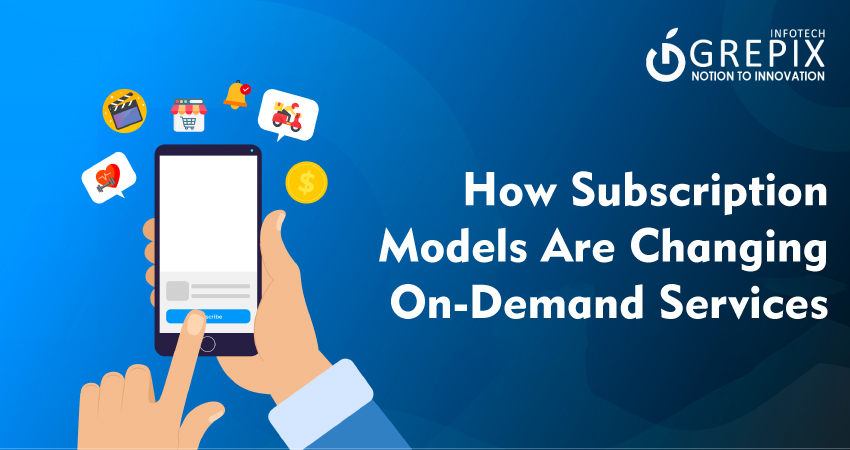How Subscription Models Are Changing On-Demand Services
The New Era of On-Demand Apps
The on-demand revolution started with simple ideas—tap a button, get a ride or order food. Fast-forward to 2025, and the landscape is unrecognizable. On-demand apps are now ecosystems of convenience—covering mobility, shopping, healthcare, logistics, and even finance.
At the center of this shift lies taxi app development. From Uber clone solutions to fully customized ride-hailing apps, businesses worldwide are innovating to keep up with rising consumer demands. Today’s users expect instant access, personalized services, transparency, and sustainability.
Let’s explore the top on-demand app trends in 2025 and break down what users expect when they open their favorite apps.
The on-demand services market, once dominated by pay-per-use, is undergoing a profound transformation driven by the rise of subscription models. This shift provides service providers with predictable recurring revenue and fosters significantly higher customer loyalty through value-added perks like priority booking, discounted rates, and exclusive services. This detailed article explores the fundamental changes that subscriptions bring to various sectors, from delivery and logistics (like a Porter Clone) to home services (mirroring an UrbanClap Clone App). We delve into the critical role of these models in business scaling, discuss the varying on-demand delivery app development cost, and analyze how businesses are adopting hybrid monetization strategies for maximum growth. The future of the on-demand application relies heavily on this recurring revenue model for stability and enhanced Customer Lifetime Value (CLV).
The Subscription Economy: Revolutionizing the On-Demand Application Landscape
The rise of the "on-demand" economy promised instant gratification—services at the tap of a button. For years, the foundational business model was purely transactional: a one-time payment for a one-time service. However, this pay-per-use structure presented significant challenges, including volatile revenue streams, high customer acquisition costs, and low customer loyalty.
A dramatic shift is now underway. Businesses are integrating and, in some cases, migrating entirely to subscription models. This change is not just a payment preference; it’s a strategic business evolution that addresses core pain points for both consumers and service providers in the fast-paced world of on-demand application services. The move towards predictable, recurring income is reshaping everything from food delivery to home maintenance.
The Strategic Shift: Why On-Demand Services are Adopting Subscription Models
The primary driver for this transition is stability. Transactional models are inherently risky, as revenue spikes and dips based on daily demand. Subscriptions introduce a reliable source of recurring income, fundamentally improving financial forecasting and long-term planning for on-demand platforms.
Boosting Customer Lifetime Value (CLV) and Retention
In the on-demand space, acquiring a new customer is significantly more expensive than retaining an existing one. Subscription tiers incentivize repeated use by offering tangible benefits, locking customers into the ecosystem. This consistent engagement directly leads to a higher Customer Lifetime Value (CLV), a crucial metric for any scaling business.
- Priority Service: Subscribers often receive preferential treatment, like faster service times or dedicated support channels.
- Exclusive Discounts: Lower service fees or waived convenience charges for members encourage them to book exclusively through the platform.
- Perks and Bundles: Access to bundled services or premium features not available to non-subscribers provides clear, continuous value.
Ensuring Predictable and Recurring Revenue Streams
The financial stability provided by a subscription base is invaluable. Even during market downturns or seasonal lulls, the predictable monthly or annual fees keep the business operational and positioned for growth. This reliability is highly attractive to investors and essential for strategic resource allocation. It allows companies to invest confidently in improving their core on-demand application technology and expanding their service offerings.
Key On-Demand Sectors Embracing Subscription Models
The application of subscription services is expanding beyond entertainment and SaaS, finding fertile ground in physical and local on-demand sectors. This demonstrates the model's flexibility across disparate market segments.
Subscription in On-Demand Logistics and Delivery: The Porter Clone Model
Logistics and delivery platforms, popularized by systems like the Porter Clone, have adopted subscription models to serve frequent users and B2B clients better. These models often focus on waiving recurring operational fees.
- B2B Membership: Businesses that rely on daily or weekly logistics (e.g., small retailers, e-commerce vendors) pay a subscription for unlimited, discounted, or priority fleet access.
- Consumer Perks: Frequent users may pay a small monthly fee to receive free or discounted delivery on all orders, significantly increasing their order frequency. This model tackles a core challenge in logistics: the high cost of the "last mile."
Transforming Home Services: Emulating the UrbanClap Clone App
The home services sector, exemplified by the success of platforms like the UrbanClap Clone App, has seamlessly integrated subscription tiers for routine maintenance. Instead of waiting for a breakdown, customers pay for proactive care.
- Maintenance Plans: Subscriptions for annual AC servicing, regular pest control, or quarterly deep cleaning. This moves the service from reactive to proactive, ensuring long-term customer dependency.
- Premium Handyman Access: A higher tier of membership on an on-demand handyman app might offer zero-fee callouts, instant service provider assignment, or access to the highest-rated professionals. This enhances the user experience and drives up the perceived value of the subscription.
The Future of the On-Demand Handyman App: Specialized Plans
Modern on-demand handyman app solutions are moving beyond simple task-booking. They are developing specialized, trade-specific subscription packages. For instance, a ‘Plumbing Care’ subscription could include an annual inspection, emergency call-out fee waiver, and exclusive discounts on part replacements. This niche focus adds exceptional value for homeowners.
The Critical Factor: On-Demand Delivery App Development Cost and Monetization
For any business looking to enter this market, the initial investment—the on-demand delivery app development cost or the cost of building a comprehensive home services platform—is a significant consideration. The choice of a monetization strategy directly impacts the Return on Investment (ROI) and, critically, the feature set.
Breakdown of On-Demand Application Development Cost Factors
The cost to build a fully-featured, scalable on-demand application can range widely, generally starting from $30,000 for a basic product to over $150,000 for an advanced, feature-rich platform.
- Basic vs. Advanced Features: Basic apps include registration, booking, and payment. Advanced apps, like a premium UrbanClap Clone App, incorporate AI-powered matching, in-app chat, real-time tracking, dynamic pricing, and comprehensive CRM/Admin dashboards.
- Platform (Native vs. Cross-Platform): Building native apps for both iOS and Android is more expensive than a single cross-platform solution.
- Team Location and Expertise: Development rates vary significantly by geographic location (e.g., North America vs. Asia).
Integrating Subscription Logic into the Core Platform
A successful subscription model requires robust technical architecture. It’s not just a payment gateway; it involves complex recurring billing logic, automated renewal alerts, tier-specific feature access control, and sophisticated churn prediction analytics. This integration adds complexity and cost, but it is a non-negotiable part of the platform's long-term value.
Hybrid Monetization: Commission and Subscription
Most modern on-demand services do not rely on a single revenue stream. They employ a hybrid model, combining transactional commissions with a tiered subscription offering. For instance, a Porter Clone might charge a 15% commission per booking to non-subscribing drivers but offer a flat-fee monthly subscription to drivers for unlimited, zero-commission bookings. This caters to different provider needs while maximizing platform revenue.
Enhancing User Experience (UX) and Loyalty with Subscription Perks
The true power of the subscription model lies in its ability to transform the user experience from a necessary transaction into a valued partnership. Subscribers feel a sense of ownership and belonging, which dramatically improves brand loyalty.
The 'Stickiness' Factor: Making the On-Demand Application Indispensable
Subscription features are designed to create 'stickiness'—making it inconvenient for the user to switch to a competitor. Free returns, waived cancellation fees, or member-only customer support make the service difficult to abandon. For a platform running an on-demand home services app, this stickiness ensures that when a need arises, the subscriber instinctively opens your app first, bypassing a competitive search.
Leveraging Data for Hyper-Personalization
Subscribers offer a goldmine of consistent behavioral data. This data allows the platform to offer hyper-personalized services, discounts, and product recommendations.
- A Porter Clone can analyze a business's shipment frequency and suggest an optimized subscription plan for their exact logistic needs.
- An UrbanClap Clone App can track a homeowner’s appliances and schedule proactive maintenance alerts, adding genuine, thoughtful value.
The shift to subscription models transforms one-time customers into high-value, recurring members, drastically improving CLV and stabilizing business finances.
Also Read: "Subscription Models in On-Demand Apps: Why They Work"
Overcoming Challenges and Ensuring Subscription Success
While the benefits are clear, the transition to a subscription-first approach presents its own set of challenges, most notably the risk of "subscription fatigue" and the need for continuous value delivery.
Combating Subscription Fatigue with Tangible Value
Consumers are saturated with subscriptions (Netflix, Spotify, SaaS tools). To succeed, an on-demand application must ensure that the perceived value of the subscription consistently exceeds its cost. This means moving beyond simple discounts and offering genuine, exclusive benefits.
Example: The Premium Handyman App: The subscription doesn't just offer lower prices; it guarantees a service professional within two hours for emergency repairs. This is a life-changing, tangible benefit that justifies the recurring fee.
Balancing Commission and Subscription for Service Providers
A major operational hurdle, especially for an on-demand handyman app or delivery service, is structuring the payment model for providers. A blend of commission-based work for casual providers and a subscription model for dedicated, professional partners is often the optimal strategy. This ensures a large pool of workers while securing the loyalty of top-tier talent.
Conclusion: The Future is Recurring for On-Demand Services
The transactional era of on-demand services is yielding to the stability and customer-centricity of the subscription model. This strategic evolution offers a robust solution to the sector's historical volatility, ensuring a predictable revenue pipeline and dramatically increasing customer loyalty. For companies looking to build the next market leader—whether a Porter Clone in logistics or a sophisticated UrbanClap Clone App in home services—the integration of a tiered subscription offering is no longer optional. It is the cornerstone of a sustainable, scalable, and high-CLV business model.
If you are planning to build a high-growth on-demand application, understanding and expertly implementing a recurring revenue model is critical. We encourage you to partner with a technology expert like Grepixit to navigate the complexities of on-demand delivery app development cost and create a feature-rich, SEO-friendly platform designed for the subscription-driven future. Embrace the subscription economy to turn single transactions into enduring customer relationships.
FAQs Section: Subscription Models in On-Demand Services
1. What is the estimated on-demand delivery app development cost for a subscription-based model?
The cost for a subscription-enabled app typically ranges from $60,000 to over $150,000, accounting for the complex recurring billing logic and dedicated management dashboards.
2. How does a subscription model help an on-demand handyman app increase retention?
It boosts retention by offering tangible, high-value perks like priority scheduling, waived surge pricing, and guaranteed rapid emergency response, making the service difficult to leave.
3. Is it better to develop an UrbanClap Clone App with a commission or a subscription model?
A hybrid model is best. Use commissions for casual transactions and a premium subscription tier for power users and dedicated service providers to maximize overall revenue.
4. What is a Porter Clone in the context of subscription services?
A Porter Clone is a logistics/trucking app that offers B2B clients a recurring monthly fee for discounted, priority, and often unlimited vehicle bookings, ensuring guaranteed capacity.
5. What features are necessary in an on-demand application to support a recurring subscription?
Key features include an integrated recurring billing system, a user-facing subscription management dashboard (for self-service), and robust churn rate analytics.







